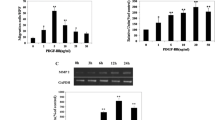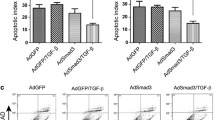Abstract
Excessive proliferation of vascular smooth muscle cells is one of the main pathological processes leading to atherosclerosis and intimal hyperplasia after vascular interventional therapy. Our previous study has shown that interferon-γ inducible protein-10 contributes to the proliferation of vascular smooth muscle cell. However, the underlying mechanisms remain unclear. Extracellular signal-regulated kinase 1/2, serine/threonine kinase Akt, and cAMP response element binding protein are signaling pathways, which are considered to play important roles in the processes of vascular smooth muscle cell proliferation. Moreover, chemokine receptor 3 and Toll-like receptor 4 are potential receptors of inducible protein-10 in this process. In the present study, IP-10 was found to directly induce vascular smooth muscle cell proliferation, and exposure to inducible protein-10 activated extracellular signal-regulated kinase 1/2, serine/threonine kinase, and cAMP response element binding protein signaling. Inhibitor of extracellular signal-regulated kinase 1/2, rather than inhibitor of serine/threonine kinase, inhibited the phosphorylation of cAMP response element binding protein and reduced inducible protein-10-stimulated vascular smooth muscle cell proliferation. Knockdown of cAMP response element binding protein by siRNA inhibited inducible protein-10-induced vascular smooth muscle cell proliferation. Moreover, anti-CXCR3 IgG, instead of anti-Toll-like receptor 4 IgG, reduced inducible protein-10-induced vascular smooth muscle cell proliferation and inducible protein-10-stimulated extracellular signal-regulated kinase 1/2 and cAMP response element binding protein activation. Together, these results indicate that inducible protein-10 promotes vascular smooth muscle cell proliferation via chemokine receptor 3 and activation of extracellular signal-regulated kinase 1/2 inducible protein-10-induced vascular smooth muscle cell proliferation. These data provide important targets for future studies to modulate atherosclerosis and restenosis after vascular interventional therapy.





Similar content being viewed by others
References
Yajima, N., Takahashi, M., & Morimoto, H. (2008). Critical role of bone marrow apoptosis-associated speck-like protein, an inflammasome adaptor molecule, in neointimal formation after vascular injury in mice. Circulation, 117(24), 3079–3087.
Lusis, A. J. (2000). Atherosclerosis. Nature, 407(6801), 233–241.
Han, D. K., Haudenschild, C. C., & Hong, M. K. (1995). Evidence for apoptosis in human atherogenesis and in a rat vascular injury model. The American Journal of Pathology, 147(2), 267–277.
Lee, E. Y., Lee, Z. H., & Song, Y. W. (2009). CXCL10 and autoimmune diseases. Autoimmunity Reviews, 8(5), 379–383.
Luster, A. D., Unkeless, J. C., & Ravetch, J. V. (1985). Gamma-interferon transcriptionally regulates an early-response gene containing homology to platelet proteins. Nature, 315(6021), 672–676.
Lasagni, L., Francalanci, M., & Annunziato, F. (2003). An alternatively spliced variant of CXCR3 mediates the inhibition of endothelial cell growth induced by IP-10, Mig, and I-TAC, and acts as functional receptor for platelet factor 4. The Journal of Experimental Medicine, 197(11), 1537–1549.
Wang, X., Yue, T. L., Ohlstein, E. H., Sung, C. P., & Feuerstein, G. Z. (1996). Interferon-inducible protein-10 involves vascular smooth muscle cell migration, proliferation, and inflammatory response. The Journal of Biological Chemistry, 271(39), 24286–24293.
Zuojun, H., Lingyu, H., & Wei, H. (2012). Interference of IP-10 expression inhibits vascular smooth muscle cell proliferation and intimal hyperplasia in carotid artery: A new insight in the prevention of restenosis. Cell Biochemistry and Biophysics, 62(1), 125–135.
Lin, J., Zhou, S., Zhao, T., Ju, T., & Zhang, L. (2016). TRPM7 channel regulates ox-LDL-induced proliferation and migration of vascular smooth muscle cells via MEK-ERK pathways. FEBS Letters, 590(4), 520–532.
Liu, Q. F., Yu, H. W., & Sun, L. L. (2015). Apelin-13 upregulates Egr-1 expression in rat vascular smooth muscle cells through the PI3K/Akt and PKC signaling pathways. Biochemical and Biophysical Research Communications, 468(4), 617–621.
Alonso, N., Diaz, N. A., & Monczor, F. (2016). PI3K pathway is involved in ERK signaling cascade activation by histamine H2R agonist in HEK293T cells. Biochimica et Biophysica Acta, 1860(9), 1998–2007.
Xing, J., Ginty, D. D., & Greenberg, M. E. (1996). Coupling of the RAS-MAPK pathway to gene activation by RSK2, a growth factor-regulated CREB kinase. Science, 273(5277), 959–963.
Tokunou, T., Ichiki, T., & Takeda, K. (2001). cAMP response element-binding protein mediates thrombin-induced proliferation of vascular smooth muscle cells. Arteriosclerosis, Thrombosis, and Vascular Biology, 21(11), 1764–1769.
Weng, Y., Siciliano, S. J., & Waldburger, K. E. (1998). Binding and functional properties of recombinant and endogenous CXCR3 chemokine receptors. The Journal of Biological Chemistry, 273(29), 18288–18291.
Schulthess, F. T., Paroni, F., & Sauter, N. S. (2009). CXCL10 impairs beta cell function and viability in diabetes through TLR4 signaling. Cell Metabolism, 9(2), 125–139.
Hodges-Garcia, Y. K., Madigan, N., & Horwitz, L. D. (1998). Primary human vascular smooth muscle cell culture enhanced by human umbilical cord serum. In Vitro Cellular & Developmental Biology. Animal, 34(5), 364–366.
Bonacchi, A., Romagnani, P., & Romanelli, R. G. (2001). Signal transduction by the chemokine receptor CXCR3: Activation of Ras/ERK, Src, and phosphatidylinositol 3-kinase/Akt controls cell migration and proliferation in human vascular pericytes. The Journal of Biological Chemistry, 276(13), 9945–9954.
Shen, Q., Zhang, R., & Bhat, N. R. (2006). MAP kinase regulation of IP10/CXCL10 chemokine gene expression in microglial cells. Brain Research, 1086(1), 9–16.
Ji, R., Lee, C. M., & Gonzales, L. W. (2008). Human type II pneumocyte chemotactic responses to CXCR3 activation are mediated by splice variant A. American Journal of Physiology. Lung Cellular and Molecular Physiology, 294(6), L1187–L1196.
Jinquan, T., Jing, C., & Jacobi, H. H. (2000). CXCR3 expression and activation of eosinophils: Role of IFN-gamma-inducible protein-10 and monokine induced by IFN-gamma. Journal of Immunology, 165(3), 1548–1556.
Sahin, H., Borkham-Kamphorst, E., & Do, O. N. (2013). Proapoptotic effects of the chemokine, CXCL 10 are mediated by the noncognate receptor TLR4 in hepatocytes. Hepatology, 57(2), 797–805.
Luster, A. D., & Ravetch, J. V. (1987). Biochemical characterization of a gamma interferon-inducible cytokine (IP-10). The Journal of Experimental Medicine, 166(4), 1084–1097.
Taub, D. D., Longo, D. L., & Murphy, W. J. (1996). Human interferon-inducible protein-10 induces mononuclear cell infiltration in mice and promotes the migration of human T lymphocytes into the peripheral tissues and human peripheral blood lymphocytes-SCID mice. Blood, 87(4), 1423–1431.
Taub, D. D., Lloyd, A. R., & Conlon, K. (1993). Recombinant human interferon-inducible protein 10 is a chemoattractant for human monocytes and T lymphocytes and promotes T cell adhesion to endothelial cells. The Journal of Experimental Medicine, 177(6), 1809–1814.
Heller, E. A., Liu, E., & Tager, A. M. (2006). Chemokine CXCL10 promotes atherogenesis by modulating the local balance of effector and regulatory T cells. Circulation, 113(19), 2301–2312.
Moon, Y., Yang, H., & Kim, Y. B. (2007). Up-regulation of early growth response gene 1 (EGR-1) via ERK1/2 signals attenuates sulindac sulfide-mediated cytotoxicity in the human intestinal epithelial cells. Toxicology and Applied Pharmacology, 223(2), 155–163.
Shen, Y. J., Zhu, X. X., & Yang, X. (2014). Cardamonin inhibits angiotensin II-induced vascular smooth muscle cell proliferation and migration by downregulating p38 MAPK, Akt, and ERK phosphorylation. Journal of Natural Medicines, 68(3), 623–629.
Kim, J. Y., Kim, K. H., & Lee, W. R. (2015). Apamin inhibits PDGF-BB-induced vascular smooth muscle cell proliferation and migration through suppressions of activated Akt and Erk signaling pathway. Vascular Pharmacology, 70(4), 8–14.
Gonzalez, G. A., & Montminy, M. R. (1989). Cyclic AMP stimulates somatostatin gene transcription by phosphorylation of CREB at serine 133. Cell, 59(4), 675–680.
Schwarz, J. B., Langwieser, N., & Langwieser, N. N. (2009). Novel role of the CXC chemokine receptor 3 in inflammatory response to arterial injury: Involvement of mTORC1. Circulation Research, 104(2), 189–200.
Acknowledgements
We thankfully acknowledge the financial support provided by the National Natural Science Foundation of China (Grant # 31271459); National 863 plans projects of China (Grant # 2013AA032203); Natural Science Foundation of Guangdong Province (Grant # S201201008687); Key Induction Project of Science and Technology, Guangdong Province (Grants # 2010B031600055).
Author information
Authors and Affiliations
Corresponding author
Ethics declarations
Conflicts of interest
The authors declare that they have no conflicts of interest.
Additional information
Hui-jin Wang, Yu Zhou and Rui-ming Liu contributed equally to this work
Rights and permissions
About this article
Cite this article
Wang, Hj., Zhou, Y., Liu, Rm. et al. IP-10/CXCR3 Axis Promotes the Proliferation of Vascular Smooth Muscle Cells through ERK1/2/CREB Signaling Pathway. Cell Biochem Biophys 75, 139–147 (2017). https://doi.org/10.1007/s12013-017-0782-9
Received:
Accepted:
Published:
Issue Date:
DOI: https://doi.org/10.1007/s12013-017-0782-9




